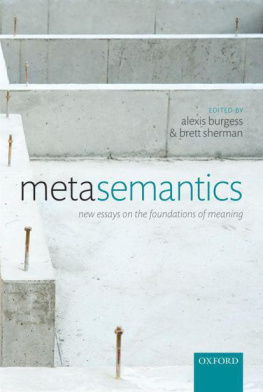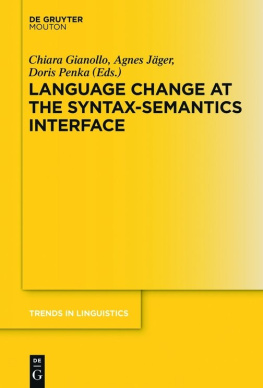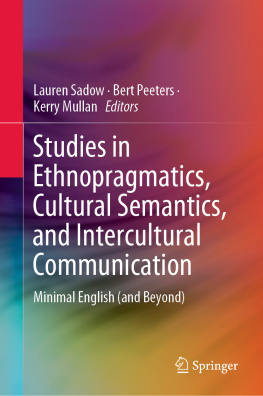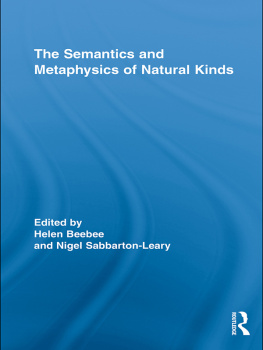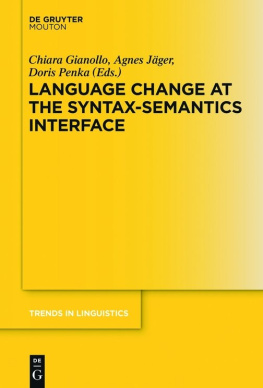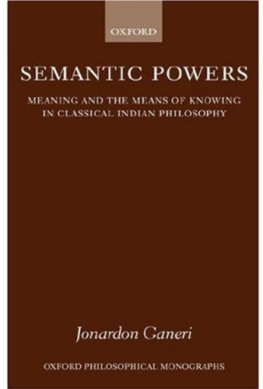Metasemantics
New Essays on the Foundations of Meaning
edited by
Alexis Burgess
and Brett Sherman


Great Clarendon Street, Oxford, OX2 6DP, United Kingdom
Oxford University Press is a department of the University of Oxford. It furthers the Universitys objective of excellence in research, scholarship, and education by publishing worldwide. Oxford is a registered trade mark of Oxford University Press in the UK and in certain other countries
the several contributors 2014
The moral rights of the authors have been asserted
First Edition published in 2014
Impression: 1
All rights reserved. No part of this publication may be reproduced, stored in a retrieval system, or transmitted, in any form or by any means, without the prior permission in writing of Oxford University Press, or as expressly permitted by law, by licence or under terms agreed with the appropriate reprographics rights organization. Enquiries concerning reproduction outside the scope of the above should be sent to the Rights Department, Oxford University Press, at the address above
You must not circulate this work in any other form and you must impose this same condition on any acquirer
Published in the United States of America by Oxford University Press 198 Madison Avenue, New York, NY 10016, United States of America
British Library Cataloguing in Publication Data Data available
Library of Congress Control Number: 2014931225
ISBN 9780199669592
ebook ISBN 9780191027192
Printed and bound by CPI Group (UK) Ltd, Croydon, CR0 4YY
Links to third party websites are provided by Oxford in good faith and for information only. Oxford disclaims any responsibility for the materials contained in any third party website referenced in this work.
Preface
Philosophy of language and linguistic semantics in the sense in which we know them today grew out of work in the philosophy of mathematics by Gottlob Frege and Bertrand Russell at the end of the 19th and the beginning of the 20th centuries. Although their legacy for the study of natural language has been unsurpassed, it was mathematics rather than language that was their primary focus. For them, the connection between mathematics and language was forged by modern symbolic logic which they, and most particularly Frege, did so much to bring into being. Although the invention of first and higherorder versions of the predicate calculus had to wait several decades for the invention of formal model theory, Frege and Russell provided plenty of informal semantic ideaswhich continue to be sources of insights for philosophers and linguists todayabout how their logical languages (as well as ours) are to be understood. With the development and application of model theory by Tarski, Carnap, and others in the 1930s, we had ways of asking and answering precise questions about the truth of sentences and the reference of other expressions of formalized languages that were related, albeit in ways that were not always very well understood, to genuine semantic questions about meaning. This was a great step forward.
The next great conceptual advance was the move to intensional logic/semanticsby which I mean systems in which sentences are evaluated at indices including world states and/or times, and possibly other parameters. Historical pride of place goes to the development of modal logic, from the early prooftheoretic investigations of C.I. Lewis, Ruth Marcus, and Rudolf Carnap through the development of a precise and powerful model theory by Saul Kripke and others. The new logic brought with it a new philosophical focus.
Since the distinction between necessity and contingency plays no role in mathemat ics, the interest in logics of necessity and possibility came from sources quite different from Freges and Russells concern with mathematics. One source was the ubiquity of modal reasoning in philosophy itself, as well as its potential use in empirical science. Another, more important, source came from the Fregean conception of language that informed his development of logic from the start. On that conception, for S to be meaningful is for S to represent the world as being a certain way, which is to impose conditions the world must satisfy, if it is to be the way S represents it. Since these are the truth conditions of S, being meaningful involves having truth conditions. Hence, it was naturally thought, the systematic study of meaning requires a framework for specifying the truth conditions of sentences on the basis of their grammatical structure and the representational contents of their parts. One approach, championed by Donald Davidson and still favored by some up to the present day, attempts to implement this idea within an extensionalist truththeoretic framework. However, it is the intensionalist approach that has become, for most, the system of choice. With modal logic, the truth conditions of sentencesprovided by an intended model plus the theory of truth at a worldstate of a modelbecame, for the first time, strong enough to be rough approximations of the meanings of (some) sentences. For surely, to learn what the world would have to be like to conform to the way a sentence represents it to be is to learn something that approximates its meaning.
The significance of this development for the study of language can hardly be over estimated. On reaching this stage, we had both a putative answer to the question, What is the meaning of a (certain type of) sentence?, and a systematic way of generating answers to it for individual sentences. The putative answer is that the meaning of a sentence of the relevant sort is its truth conditions, which are modeled by the set of those states w such that if the world were in w, then it would be as S represents it to be. The systematic method for studying meaning is to derive these truth conditions compositionally from the interpretations of words occurring in the sentences. With this, it was widely believed, we had a semantic framework that could be applied to languages in general.
This is where the philosophically inspired study of linguistically encoded information stood around 1960. Since then, philosophers, philosophical logicians, and theoretical linguists have expanded the framework to cover increasingly large portions of natural languages. This research programto which Richard Montague, Robert Stalnaker, David Lewis, David Kaplan, Hans Kamp, Barbara Partee, Angelica Kratzer, Irene Heim, Jon Barwise, and many others have contributed greatlyhas given us modal, temporal, and counterfactual operators, generalized quantifiers, adverbial modifiers including adverbs of quantification, comparatives, intensional transitives, indexicals, demonstratives, and many other constructions relevant to understanding both individual sentences and connected discourses. Thus, what began as a spinoff of philosophical investigations of logic and mathematics, and was nourished by developments in model theory and intensional logic, has emerged in the last forty years as a fledgling but increasingly independent science.
However, the empirical study of linguistic meaning is not yet the kind of mature science the philosophical interest in which is overwhelmingly second-order, on a par with philosophical interest in mathematics, physics, or biology. Instead, it has reached the point at which it must expand beyond the paradigms inherited and adapted from philosophical logic to accommodate features of the use of natural lan guage that were not the focus of the founders of philosophical semantics. Evaluative sentences and epistemic modals are two cases in point. Are they representational in the same way that nonevaluative sentences and metaphysical modals are? If so, are they associated with a second dimension of meaning, or a special pragmatics, over and above their representational content? If they arent representational, what kind of nonrepresentational meaning do they have? Another crucial issue, seemingly pro saic but pregnant with theoretical import (not least for the identification of genuine semantic values), is the interpenetration of semantic and pragmatic information in assertive content, arising from shared presuppositions, and coordinated expectations of speakers and hearers. Although work on this issue is well underway, the scope, variety, and richness of the domain leave plenty of room for farreaching theoretical innovation.

